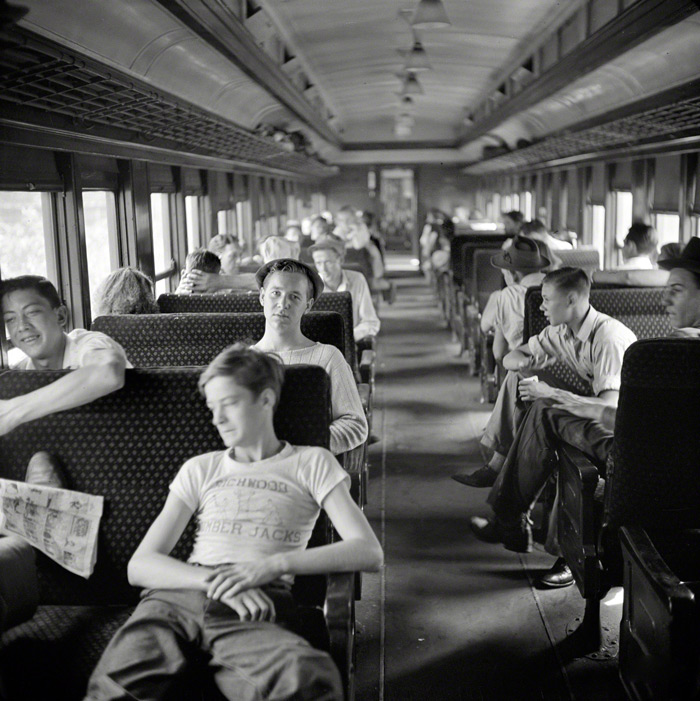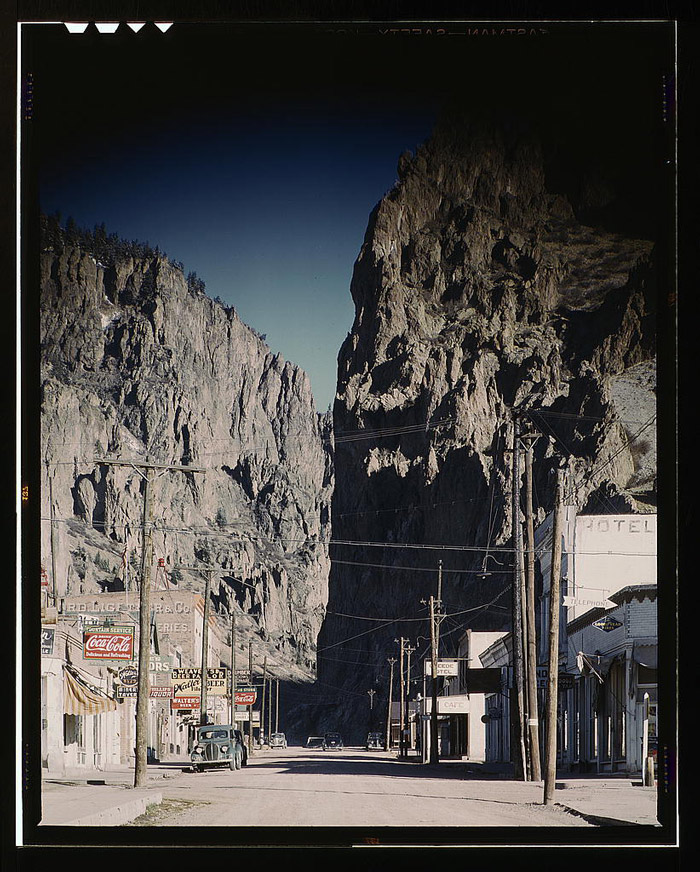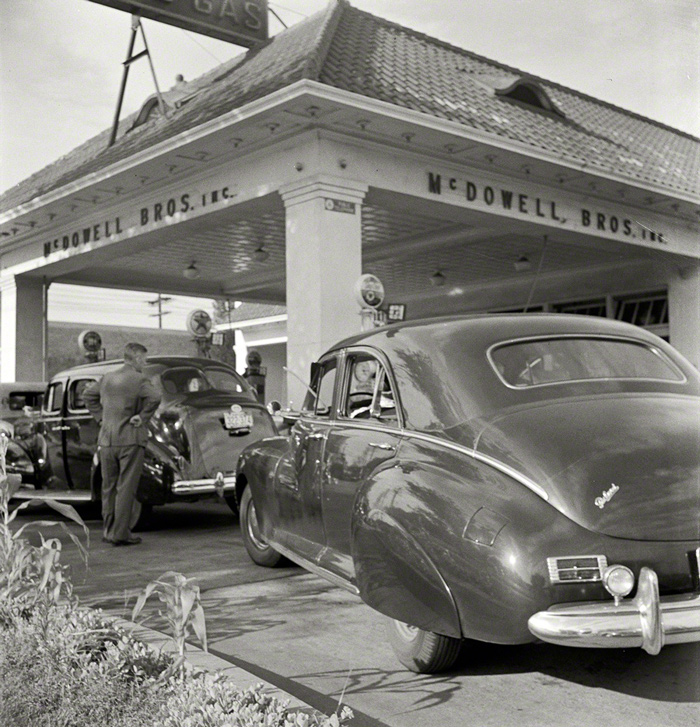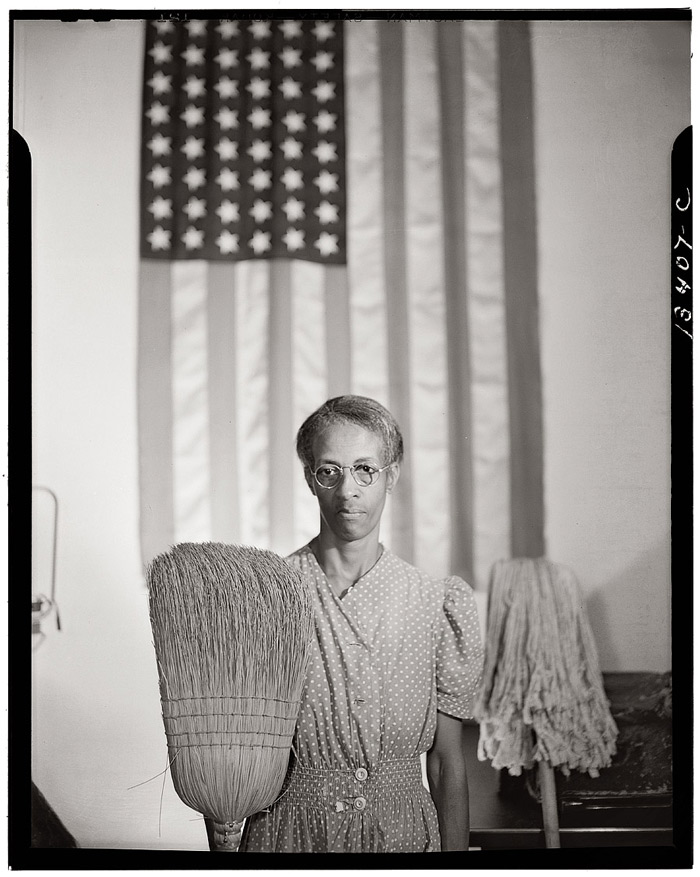Hole in the Clouds
Apr 17, 2012
 Another sample from the Library of Congress's small collection of color photos from the 1930s and 1940s, this one shows a woman working with aerial photos to develop camouflaging for airfields and critical factories during World War II.
Another sample from the Library of Congress's small collection of color photos from the 1930s and 1940s, this one shows a woman working with aerial photos to develop camouflaging for airfields and critical factories during World War II.
Camouflage experts at New York University would use the aerial photos to build a model of an area that included the facility to be camouflaged. Then they would paint over the facility on the model until it blended in with its surroundings. Aircraft plants on the West Coast were covered with acres of canvas and plywood painted and sculpted to resemble suburban subdivisions. Airstrips were painted to look like small-town streets and farmland from the air.
Not everything was so easy to camouflage; ships at sea, for example, proved impossible to hide no matter how they were painted. A completely different approach, known as dazzle camouflage, was devised for ships; they were painted with crazy stripes at jagged angles, visible from afar but very different to interpret as to size, direction, and speed of movement.
Some fighter planes were painted pale pink, a color that was thought to show up as white or grayish, like clouds, at high angles of intense sunlight.
This photo looks posed, and the woman may be a model rather than a serious camouflage authority; she is holding the aerial photo more or less upside down with respect to the model she's supposedly painting.
art
World War II
1942
camouflage
New York University
(Image credit: Office of War Information)
Sep 22, 2013
 By the summer of 1942, the American war effort was in such high gear that many agricultural regions were experiencing a severe labor shortage. All the young men were serving in the military, almost everybody else was working in war industries, and nobody was left to pick the nation's peas and beans.
By the summer of 1942, the American war effort was in such high gear that many agricultural regions were experiencing a severe labor shortage. All the young men were serving in the military, almost everybody else was working in war industries, and nobody was left to pick the nation's peas and beans.
As part of a program designated "Food for Victory," this specially chartered train brought more than three hundred high school boys and girls from the coal-mining town of Richwood, West Virginia, to the farming district around Batavia in upstate New York, where they would pick peaches, apples, tomatoes, and other crops. The program also brought in teenagers from other non-farming places, including Brooklyn, New York, where one of the high schoolers who signed on to help with the harvest upstate was the young Helen Ruskin, Norman's mother.
New York
West Virginia
Helen
train
World War II
high school
1942
youth
Richwood
(Image credit: John Collier via Shorpy)
Jul 15, 2012
 The main street of Creede, Colorado, led to the mouth of an important lead and zinc mine in 1942, when the picture above--part of a small series of color photos commissioned by government agencies in the 1930s and 1940s--was taken for the Office of War Information. The mine remained active until 1985 and has recently been reopened; in fact, it is currently advertising for mechanics to troubleshoot and maintain lead mining equipment.
The main street of Creede, Colorado, led to the mouth of an important lead and zinc mine in 1942, when the picture above--part of a small series of color photos commissioned by government agencies in the 1930s and 1940s--was taken for the Office of War Information. The mine remained active until 1985 and has recently been reopened; in fact, it is currently advertising for mechanics to troubleshoot and maintain lead mining equipment.
Back in the late nineteenth century, silver was extracted from Creede ore, and more than ten thousand people crowded into the area. But ever since the silver panic of 1897, local mines have produced mostly lead, and fewer than a thousand people have lived here; the 2010 census counted 290.
A Western based on the Lone Ranger story and starring Johnny Depp will feature scenes shot in and around Creede. It is set for release in 2013.
Below is Creede's Main Street as it looked in 2005.

streetscape
World War II
1942
mine
Colorado
Office of War Information
Creede
(Image credit: Andreas Feininger)
Mar 23, 2013
 By 7 a.m. on June 21, 1942, the line of cars at this Texaco station, and at pretty much every gas station in America, spilled out of the lot and on down the street. Strict gas rationing to conserve fuel for the war effort was set to begin the next day, June 22, 1942.
By 7 a.m. on June 21, 1942, the line of cars at this Texaco station, and at pretty much every gas station in America, spilled out of the lot and on down the street. Strict gas rationing to conserve fuel for the war effort was set to begin the next day, June 22, 1942.
Note the corn plants growing in the grassy spot in the lower left corner of the picture. Note also the car closest to the camera: a brand new 1942 Packard.
McDowell's Texaco was in the 5200 block of Wisconsin Avenue NW, near Friendship Heights at the edge of Washington, D.C; a parking garage now occupies the spot.
Washington
cityscape
cars
World War II
District of Columbia
1942
5252 Wisconsin Ave NW
(Image credit: Marjory Collins for Office of War Information)
Feb 8, 2017
 One of the first professional assignments undertaken by Gordon Parks was a 1942 photo essay featuring Mrs. Ella Watson, a "government charwoman" who cleaned federal office buildings at night, after the clerks went home, and supported her family, including an adopted daughter and three grandchildren, on her annual salary of $1,080.
One of the first professional assignments undertaken by Gordon Parks was a 1942 photo essay featuring Mrs. Ella Watson, a "government charwoman" who cleaned federal office buildings at night, after the clerks went home, and supported her family, including an adopted daughter and three grandchildren, on her annual salary of $1,080.
Parks's other photos of Mrs. Watson and her family, along with explanatory captions, can be viewed online, via the Library of Congress Farm Security Administration archive.
portrait
work
District of Columbia
1942
Ella Watson
(Image credit: Gordon Parks via Shorpy)
 Another sample from the Library of Congress's small collection of color photos from the 1930s and 1940s, this one shows a woman working with aerial photos to develop camouflaging for airfields and critical factories during World War II.
Another sample from the Library of Congress's small collection of color photos from the 1930s and 1940s, this one shows a woman working with aerial photos to develop camouflaging for airfields and critical factories during World War II.


